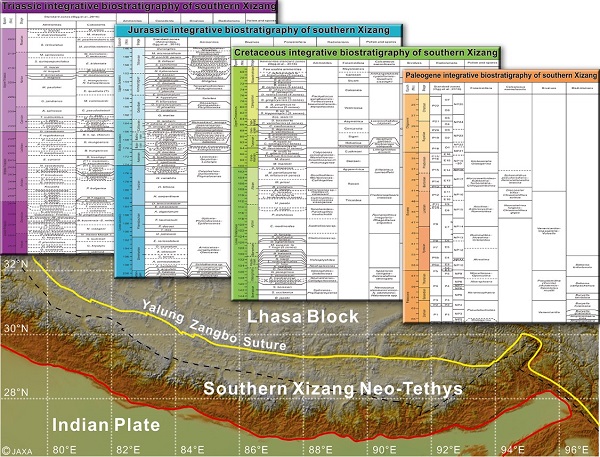Known as the third pole of the earth, the magnificent Qinghai-Xizang plateau used to be a vast ocean millions of years ago and its vicissitudes have become one of the hotspots of the geological research. Stratigraphy is the basis for diachronic reconstruction of this process, with biostratigraphy the most fundamental method and fossils often the most reliable evidence for the age of strata. However, due to extreme natural conditions and intense tectonic deformation and metamorphism, fossil collection and biostratigraphic research in the Qinghai-Xizang plateau are very difficult and the progress has been very slow. The Neo-Tethys realm in southern Xizang, as represented by the Yarlung Zangbo Suture Zone, is such a prominent sample where the Mesozoic and Cenozoic strata bear many problems and arguments, which has already become a restrict to other researches.
Recently, Professor LI Jianguo and his colleagues from Nanjing Institute of Geology and Palaeontology, Chinese Academy of Sciences (NIGPAS) established a new integrated biostratigraphic framework for the Triassic–Paleogene strata in Neo-Tethyan realm in southern Xizang based on a combination of their own material and progress and other previous researches. The results have been published online in the Journal of Asian Earth Sciences, an international comprehensive journal of geology.
Many blanks in biostratigraphy got filled in this framework and much progress has been made for fossils that were never or weakly studied in the past, particularly microfossils such as conodonts, radiolarians, and miospores. For those well-studied fossils, essential supplement or improvement has been made. The new framework is improved by a series of new biostratigraphic zones, many of which are well correlated with the international standard, such as those of Lower Triassic conodonts and ammonites, uppermost Triassic–Lower Jurassic ammonites, and Upper Cretaceous planktonic foraminifers and calcareous nanofossils. A total of four integrated biostratigraphic charts are compiled in units of period, all consisting of key fossils for stratigraphic division and correlation of that period, such as ammonites, conodonts, bivalves, radiolarians, foraminifers and calcareous nanofossils. Based on these biostratigraphic advances, the authors also discussed and clarified some questions or arguments on the definition, division, correlation and age of some Triassic to Paleogene strata in southern Xizang.
The duration of the new integrated biostratigraphic framework is roughly the time that the Neo-Tethys Ocean evolved from its opening by the rifting of Lhasa-Gondese block from the northern margin of Gondwana to its closure as a consequence of the Indian–Eurasian collision. In this respect, this research will provide as an important stratigraphic reference for the study of the evolution of Neo-Tethys and other geological researches on the Qinghai-Xizang Plateau.
The relevant research was supported by the Second Tibetan Plateau Scientific Expedition and Research, the Strategic Priority Research Program (B) of the Chinese Academy of Sciences and the National Natural Science Foundation of China.
Reference: Jianguo Li*, Miaoqin Lin, Yixiao Wu, Hui Luo, Jungang Peng, Lin Mu, Bo Xu, Chao Zhang, 2020. New biostratigraphic framework for the Triassic–Paleogene in the Neo-Tethys realm of southern Xizang (Tibet), China. Journal of Asian Earth Sciences, https://doi.org/10.1016/j.jseaes.2020.104369.

The new integrated biostratigraphic charts of the Triassic-Paleogene strata in the studied area
Download:
